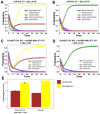DNA Damage-Induced Ferroptosis: A Boolean Model Regulating p53 and Non-Coding RNAs in Drug Resistance
- PMID: 39846637
- PMCID: PMC11755436
- DOI: 10.3390/proteomes13010006
DNA Damage-Induced Ferroptosis: A Boolean Model Regulating p53 and Non-Coding RNAs in Drug Resistance
Abstract
The tumor suppressor p53, in its wild-type form, plays a central role in cellular homeostasis by regulating senescence, apoptosis, and autophagy within the DNA damage response (DDR). Recent findings suggest that wild-type p53 also governs ferroptosis, an iron-dependent cell death process driven by lipid peroxidation. Post-translational modifications of p53 generate proteoforms that significantly enhance its functional diversity in regulating these mechanisms. A key target in this process is the cystine/glutamate transporter (xCT), which is essential for redox balance and ferroptosis resistance. Additionally, p53-induced miR-34c-5p suppresses cancer cell proliferation and drug resistance by modulating Myc, an oncogene further influenced by non-coding RNAs like circular RNA NOTCH1 (CricNOTCH1) and long non-coding RNA MALAT1. However, the exact role of these molecules in ferroptosis remains unclear. To address this, we introduce the first dynamic Boolean model that delineates the influence of these ncRNAs and p53 on ferroptosis, apoptosis, and senescence within the DDR context. Validated through gain- and loss-of-function perturbations, our model closely aligns with experimental observations in cancers such as oral squamous cell carcinoma, nasopharyngeal carcinoma, and osteosarcoma. The model identifies crucial positive feedback loops (CricNOTCH1/miR-34c/Myc, MALAT1/miR-34c/Myc, and Myc/xCT) and highlights the therapeutic potential of using p53 proteoforms and ncRNAs to combat drug resistance and induce cancer cell death.
Keywords: CricRNA NOTCH1; apoptosis; ferroptosis; lncRNA MALAT1; miR-34c-5p; p53.
Conflict of interest statement
The authors declare no conflicts of interest.
Figures






Similar articles
-
A dynamic Boolean network reveals that the BMI1 and MALAT1 axis is associated with drug resistance by limiting miR-145-5p in non-small cell lung cancer.Noncoding RNA Res. 2023 Oct 19;9(1):185-193. doi: 10.1016/j.ncrna.2023.10.008. eCollection 2024 Mar. Noncoding RNA Res. 2023. PMID: 38125755 Free PMC article.
-
Dynamical Analysis of a Boolean Network Model of the Oncogene Role of lncRNA ANRIL and lncRNA UFC1 in Non-Small Cell Lung Cancer.Biomolecules. 2022 Mar 9;12(3):420. doi: 10.3390/biom12030420. Biomolecules. 2022. PMID: 35327612 Free PMC article.
-
Unveiling the role of ferroptosis-associated exosomal non-coding RNAs in cancer pathogenesis.Biomed Pharmacother. 2024 Mar;172:116235. doi: 10.1016/j.biopha.2024.116235. Epub 2024 Feb 3. Biomed Pharmacother. 2024. PMID: 38308967 Review.
-
MiR-34c-3p upregulates erastin-induced ferroptosis to inhibit proliferation in oral squamous cell carcinomas by targeting SLC7A11.Pathol Res Pract. 2022 Mar;231:153778. doi: 10.1016/j.prp.2022.153778. Epub 2022 Jan 25. Pathol Res Pract. 2022. PMID: 35093695
-
Research progress on the role of lncRNA, circular RNA, and microRNA networks in regulating ferroptosis in osteosarcoma.Biomed Pharmacother. 2024 Jul;176:116924. doi: 10.1016/j.biopha.2024.116924. Epub 2024 Jun 14. Biomed Pharmacother. 2024. PMID: 38876052 Review.
Cited by
-
Knockdown of MIR205HG prevents cell proliferation, migration and invasion through autophagy and ferroptosis pathways in lung adenocarcinoma.Transl Cancer Res. 2025 Jun 30;14(6):3587-3598. doi: 10.21037/tcr-2024-2335. Epub 2025 Jun 27. Transl Cancer Res. 2025. PMID: 40687252 Free PMC article.
-
Plasma Circulating lncRNAs: MALAT1 and NEAT1 as Biomarkers of Radiation-Induced Adverse Effects in Laryngeal Cancer Patients.Diagnostics (Basel). 2025 Mar 10;15(6):676. doi: 10.3390/diagnostics15060676. Diagnostics (Basel). 2025. PMID: 40150019 Free PMC article.
-
The METTL3/IGF2BP1 axis-mediated m6 A modification of TRIM11 mRNA suppresses ferroptosis and accelerates malignant progression in non-small cell lung cancer cells by degrading ACSL4.Naunyn Schmiedebergs Arch Pharmacol. 2025 Jul 16. doi: 10.1007/s00210-025-04207-7. Online ahead of print. Naunyn Schmiedebergs Arch Pharmacol. 2025. PMID: 40668412
References
Grants and funding
LinkOut - more resources
Full Text Sources
Research Materials
Miscellaneous

